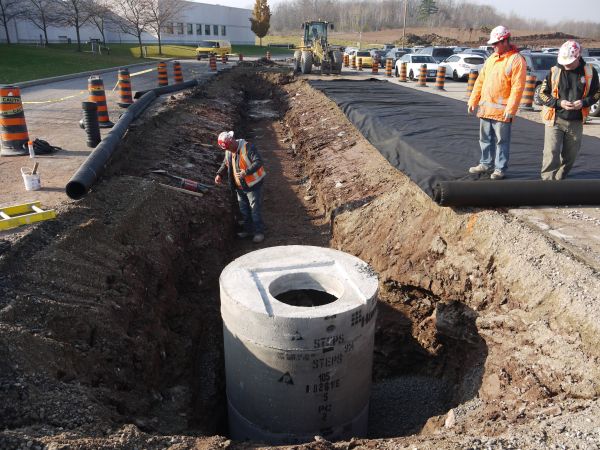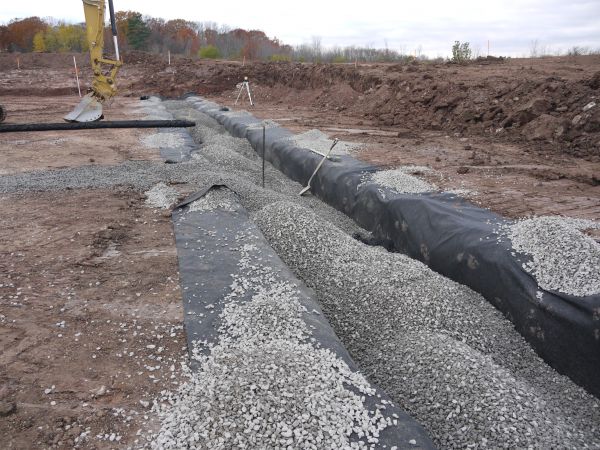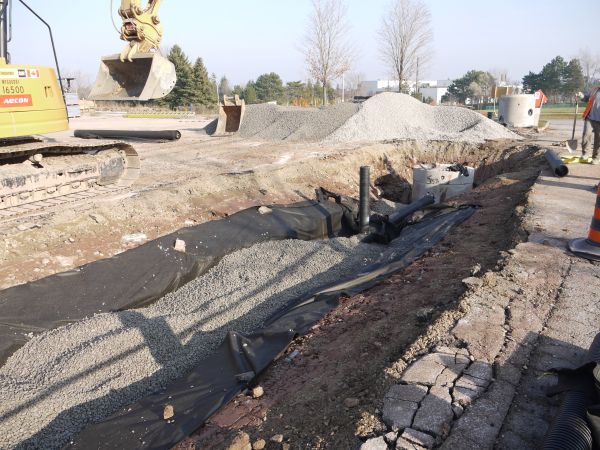Difference between revisions of "Sub-surface components"
| Line 10: | Line 10: | ||
==Geotextiles== | ==Geotextiles== | ||
| + | [[Geotextiles]] are filter fabrics that can be installed to separate dissimilar soils and prevent the migration of materials. Geotextiles are recommended for installation at the bottom and side limits of the LID feature and should be implemented at the discretion of the engineer. | ||
| − | + | '''Construction Steps:''' | |
| + | #Roll out fabric on the flattened sub-grade surface. | ||
| + | #Provide a minimum overlap of 300 mm between adjacent lengths of geotextile. If the manufacturer specifies a greater overlap, follow the manufacturer’s specification. | ||
| + | #Secure fabric in place with stakes along the edge of the sub-grade surface and where lengths of fabric overlap. | ||
| + | #Provide 500 mm of excess at the ends of each length of fabric. Fold excess materiel on top of the infiltration medium/choker course once installed. | ||
| + | #Provide cuts for trees and shrubs where appropriate. | ||
| + | #Assess on-site conditions to ensure that the tensile, tear, and puncture strength ratings of the geotextile are suitable for expected structural loads (e.g. traffic). If not properly considered, geotextiles can be adversely impacted by loading from adjacent infrastructure uses. | ||
| + | |||
| + | '''Key Inspection Points:''' | ||
| + | *Geotextile is clean and free of damage. | ||
| + | *Geotextile delivered to the site matches the design specifications and is approved by the engineer prior to installation. | ||
| + | *Sufficient overlap is provided between lengths of fabric. | ||
| + | *Geotextiles have been applied as per the manufacturer’s guidelines. | ||
| + | *Structural considerations for geotextiles have been made when applied adjacent to infrastructure and the geotextile can handle expected structural loads. | ||
| + | *Class II geotextiles conform to OPSS 1860. | ||
| + | |||
| + | '''Mistakes to Avoid:''' | ||
| + | *Wrinkles in the fabric: Follow the manufacturer’s procedure for installation to ensure geotextiles lie smooth on sub-grade. | ||
| + | *Unnecessary application of geotextile: Mixing of media is negligible where structural loads are not expected, so geotextile does not need to be applied. Also, geotextiles should not be used where root growth is encouraged to penetrate different layers of media. | ||
| + | |||
| + | <gallery mode="packed" widths=300px heights=300px> | ||
| + | geotextile-facility-side.jpg | The shape of the LID feature required the geotextile to be rolled out prior to being laid on the subgrade surface. Photo taken during construction of IMAX Corporation Headquarters. (Photo Source: CVC, 2012) | ||
| + | geotextile-with-excess-and-granular.jpg | Excess fabric is draped over the edges of the LID practice, and backfilling with granular is taking place. Photo taken during construction of IMAX Corporation Headquarters. (Photo Source: CVC, 2012) | ||
| + | geotextile-backfill-underdrain.jpg | Footprint with geotextile, granular, and underdrain. Photo taken during construction of IMAX Corporation Headquarters. (Photo Source: CVC, 2012) | ||
| + | |||
| + | </gallery> | ||
| + | |||
| + | [[Category:Gallery]] | ||
==Underdrains== | ==Underdrains== | ||
Revision as of 15:53, 28 October 2022
The construction guidance in this section applies to all sub-surface and ground-level LID practices: bioretention gardens, bioswales, rain gardens, exfiltration trenches, enhanced swales, permeable pavements, infiltration trenches, infiltration chambers, and soakaways. In general, this section describes construction and inspection processes for below ground installed materials and infrastructure that are part of the LID practices noted above.
Overview[edit]
This section gives guidance for project managers, engineers, and contractors on the installation of sub-surface components of LID practices.
Geotextiles[edit]
Geotextiles are filter fabrics that can be installed to separate dissimilar soils and prevent the migration of materials. Geotextiles are recommended for installation at the bottom and side limits of the LID feature and should be implemented at the discretion of the engineer.
Construction Steps:
- Roll out fabric on the flattened sub-grade surface.
- Provide a minimum overlap of 300 mm between adjacent lengths of geotextile. If the manufacturer specifies a greater overlap, follow the manufacturer’s specification.
- Secure fabric in place with stakes along the edge of the sub-grade surface and where lengths of fabric overlap.
- Provide 500 mm of excess at the ends of each length of fabric. Fold excess materiel on top of the infiltration medium/choker course once installed.
- Provide cuts for trees and shrubs where appropriate.
- Assess on-site conditions to ensure that the tensile, tear, and puncture strength ratings of the geotextile are suitable for expected structural loads (e.g. traffic). If not properly considered, geotextiles can be adversely impacted by loading from adjacent infrastructure uses.
Key Inspection Points:
- Geotextile is clean and free of damage.
- Geotextile delivered to the site matches the design specifications and is approved by the engineer prior to installation.
- Sufficient overlap is provided between lengths of fabric.
- Geotextiles have been applied as per the manufacturer’s guidelines.
- Structural considerations for geotextiles have been made when applied adjacent to infrastructure and the geotextile can handle expected structural loads.
- Class II geotextiles conform to OPSS 1860.
Mistakes to Avoid:
- Wrinkles in the fabric: Follow the manufacturer’s procedure for installation to ensure geotextiles lie smooth on sub-grade.
- Unnecessary application of geotextile: Mixing of media is negligible where structural loads are not expected, so geotextile does not need to be applied. Also, geotextiles should not be used where root growth is encouraged to penetrate different layers of media.
Underdrains[edit]
Impermeable liners[edit]
Impermeable liners: Installation
Overflows[edit]
Monitoring wells[edit]
Monitoring wells: Installation
Storage reservoir[edit]
Construction: storage reservoir
Permeable pavement sub-base and base course[edit]
Permeable pavement sub-base and base course
Trench, Chamber, and Perforated Pipe Installation[edit]
Trench, chamber, and perforated pipe: Installation
Stone choker layer[edit]
In LID facilities, a choker layer of ≥ 100 mm depth is recommended to prevent migration of finer filter media into the underlying storage reservoir aggregate. Similar to the storage reservoir material, this aggregate layer should be a washed 5 – 10 mm stone free from fines and debris. Installation of aggregate choker layer should not be done when frozen.
Follow the construction guidance shown above in the section Storage reservoir
For more guidance on materials specifications, refer to Aggregates, OPSS aggregates and (Ontario Provincial Standards, 2013) [1]
Curbing[edit]
Pretreatment and inlet[edit]
Construction: pretreatment and inlet
References[edit]
- ↑ Ontario Provincial Standards. 2013. OPSS.PROV.10101 Aggregates - Base, Subbase Select Subgrade, and Backfill Material. https://www.roadauthority.com/Standards/?id=a28fdfaf-3bf8-4679-81ca-4e44b2263cf8


